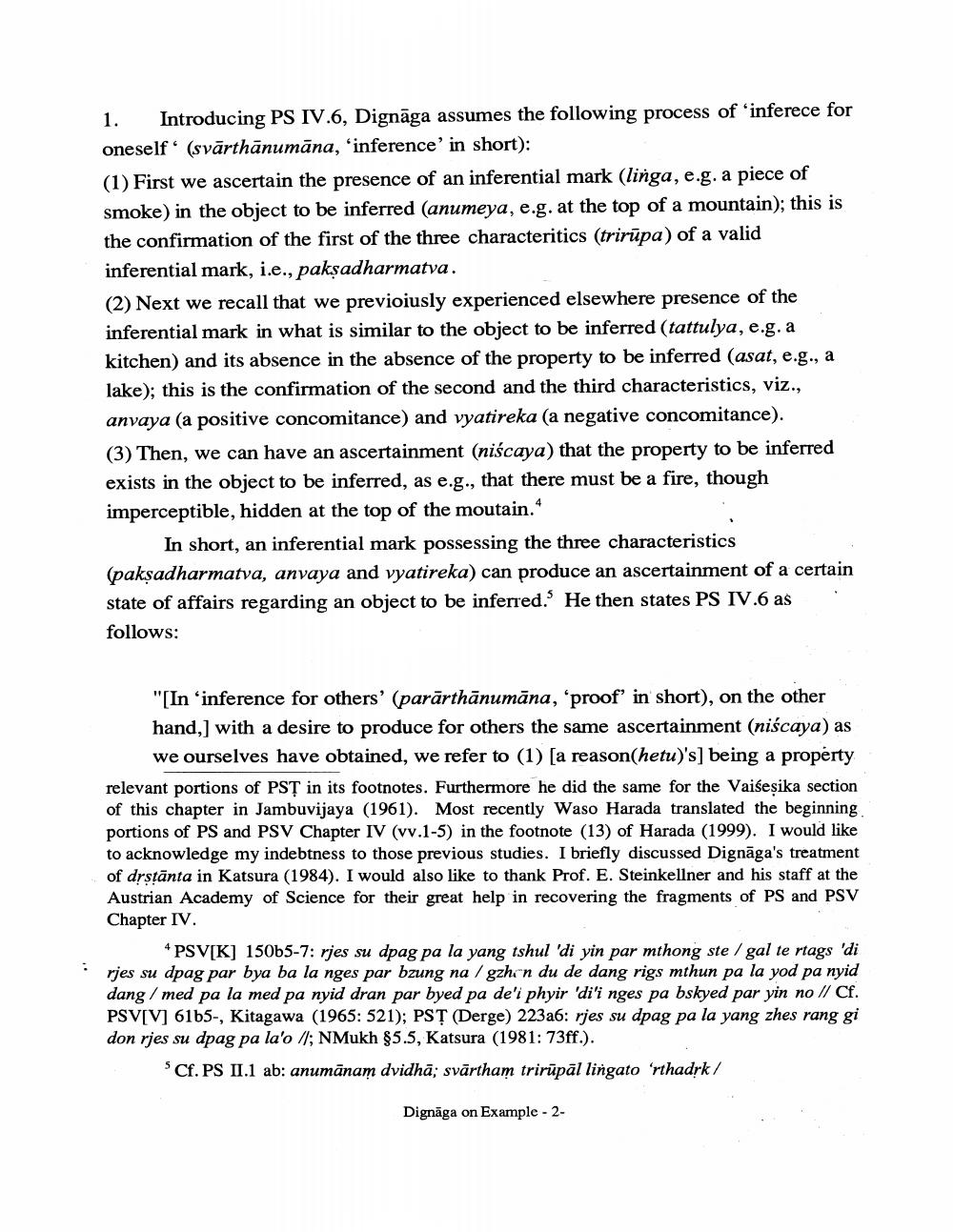Book Title: Role Of Drstanta Indignagas Logic Author(s): Shoryu Katsura Publisher: Shoryu Katsura View full book textPage 2
________________ 1. Introducing PS IV.6, Dignāga assumes the following process of 'inferece for oneself (svārthānumāna, 'inference in short): (1) First we ascertain the presence of an inferential mark (linga, e.g. a piece of smoke) in the object to be inferred (anumeya, e.g. at the top of a mountain); this is the confirmation of the first of the three characteritics (trirūpa) of a valid inferential mark, i.e., pakşadharmatva. (2) Next we recall that we previoiusly experienced elsewhere presence of the inferential mark in what is similar to the object to be inferred (tattulya, e.g. a kitchen) and its absence in the absence of the property to be inferred (asat, e.g., a lake); this is the confirmation of the second and the third characteristics, viz., anvaya (a positive concomitance) and vyatireka (a negative concomitance). (3) Then, we can have an ascertainment (niscaya) that the property to be inferred exists in the object to be inferred, as e.g., that there must be a fire, though imperceptible, hidden at the top of the moutain." In short, an inferential mark possessing the three characteristics (pakşadharmatva, anvaya and vyatireka) can produce an ascertainment of a certain state of affairs regarding an object to be inferred. He then states PS IV.6 as . follows: "[In 'inference for others' (parārthānumāna, 'proof' in short), on the other hand,] with a desire to produce for others the same ascertainment (niscaya) as we ourselves have obtained, we refer to (1) [a reason(hetu)'s] being a property relevant portions of PST in its footnotes. Furthermore he did the same for the Vaisesika section of this chapter in Jambuvijaya (1961). Most recently Waso Harada translated the beginning. portions of PS and PSV Chapter IV (vv.1-5) in the footnote (13) of Harada (1999). I would like to acknowledge my indebtness to those previous studies. I briefly discussed Dignāga's treatment of drstānta in Katsura (1984). I would also like to thank Prof. E. Steinkellner and his staff at the Austrian Academy of Science for their great help in recovering the fragments of PS and PSV Chapter IV. PSV[K] 150b5-7: rjes su dpag pa la yang tshul 'di yin par mthong ste/gal te rtags 'di rjes su dpag par bya ba la nges par bzung na / gzhon du de dang rigs mthun pa la yod pa nyid dang/med pa la med pa nyid dran par byed pa de'i phyir 'di'i nges pa bskyed par yin no // Cf. PSV[V] 61b5-, Kitagawa (1965: 521); PST (Derge) 223a6: rjes su dpag pa la yang zhes rang gi don rjes su dpag pa la'o /; NMukh $5.5, Katsura (1981: 73ff.). Cf. PS II.1 ab: anumānam dvidhā; svārtham trirūpāl lingato rthadrk / Dignāga on Example - 2Page Navigation
1 2 3 4 5 6 7 8 9 10 11 12 13 14 15 16 17 18 19 20 21 22 ... 24
